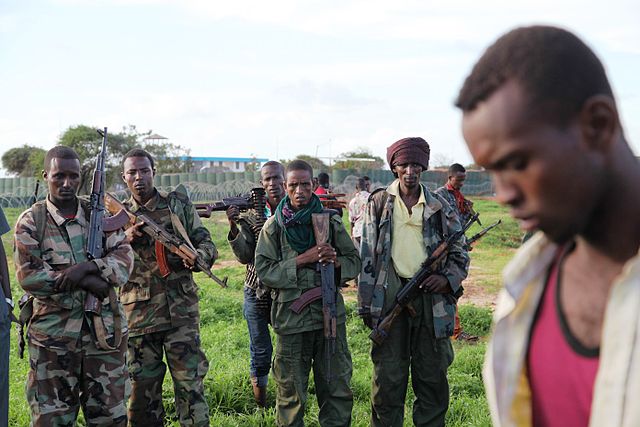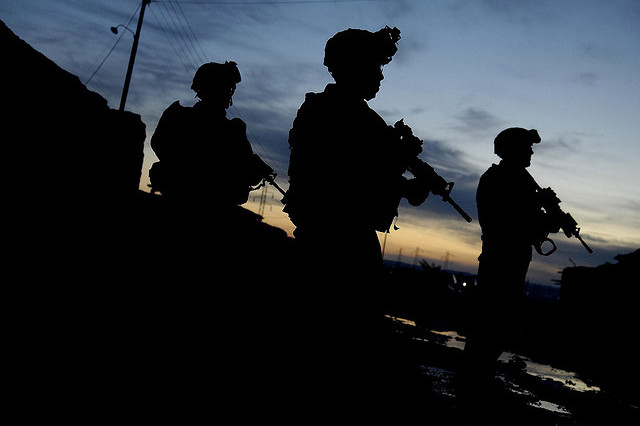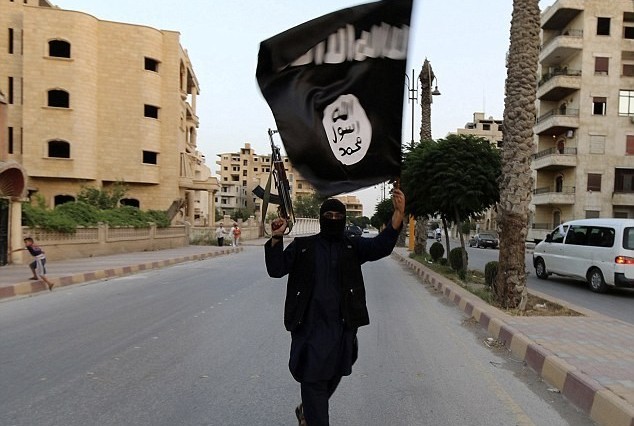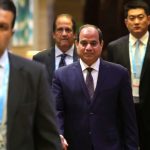by Daniel Van Lehman and Lindsay J. Benstead
President Trump—citing national security concerns—signed an executive order in April granting a one-year extension to the mandate of U.S. Special Operations Forces in Somalia. This has led many to question military involvement, especially after the release of an Amnesty International report attributing civilian deaths in Somalia to American airstrikes.
The United States has been involved in Somalia off and on since the 1990s when the failed mission to capture Mohamed Farrah Aideed’s top officials, popularly referred to as Black Hawk Down, brought the U.S. role in Somalia’s civil war into international focus. In this present phase of U.S. military involvement, 500 U.S. service members are stationed in the city of Kismayu in southern Somalia—the traditional homeland of Somali minorities—on a mission to train an elite Somali National Army (SNA) unit known as Danaab (“lighting”) to fight al-Shabaab, a Somali militia with ties to al-Qaeda. The United States also conducts drone strikes to target al-Shabaab leaders and prevent attacks against coalition troops.
Based on our research and experience working in the Horn of Africa, which includes a 2017 survey of 139 Somali minority households from the Lower and Middle Jubba Regions that we conducted through local interviewers and more than a dozen recent qualitative interviews with minority community leaders—we believe that the United States and Somalia will be unable to degrade and contain al-Shabaab with their current military strategy. To improve success and ultimately help end U.S. involvement in Somalia, U.S. military leaders must more fully integrate Somali minorities into the SNA and Danab and work with minorities to improve airstrike targets against al-Shabaab, rather than relying on majority-clan members with little incentive to defeat the terrorist network.
Somalia’s Complex Clan Geography
Somalia is not a homogeneous country. Those Somalis who do not belong genealogically to one of the four majority clans—Darood, Hawiye, Dir/Isaaq, and Rahanweyn/Digil Mirifle—are classified in the Somali constitution and political system as “minorities.” The Somali Bantu nationwide are the largest of the minority groups and, despite being referred to as minorities, may make up to 40 percent of the national population. They face severe discrimination and are grossly underrepresented in the country’s system of power-sharing known as the 4.5 framework. Minorities are also largely excluded from political and military positions, including those the United States is training, especially at the senior level.
Southern Somalia is the homeland of the Somali Bantu (locally known as Jareer). It is also ground zero in the fight against al-Shabaab. Yet the Lower and Middle Jubba Regions (Image 1) are governed not by the Somali Bantu but by the Interim Jubbaland Administration (IJA), a majority-clan regional government. This fact helps explain why the United States and Somalia have had limited success against al-Shabaab. The IJA, which benefits from the wartime economy and seeks to strengthen its control of the region’s resources, obstructs efforts by the United States and SNA to degrade and contain al-Shabaab. Preventing the equal representation of the Somali Bantu in the SNA and Danab is a key element of the IJA’s obstruction.
The president of the IJA, Ahmed Mohamed Islam (Ahmed Madobe), and an overwhelming majority of his militia fighters are from the Ogaden sub-clan of the larger Darood clan. The Ogaden clan is not native to Kismayu. In addition to positioning Ogadeni Somalis in Kismayu, Ahmed Madobe has recruited to the city Ogaden clan members from their other native regions in Kenya’s Northeastern Province and southern Ethiopia’s Ogaden region. Ahmed Madobe’s militia conquered Kismayu years ago to control and exploit the land, labor, and infrastructure in southern Somalia. In addition to committing human rights abuses against the Somali Bantu, the IJA has partnered with al-Shabaab in the illegal and lucrative transnational trade in sugar and charcoal, according to the UN. The governing body in the Lower and Middle Jubba Regions stands in the way of any real success by the United States and the SNA to reduce the influence of al-Shabaab.
Kismayo shown at the Southern tip of Somalia. Map of the five administrative districts in the Lower and Middle Jubba Regions claimed by the Interim Jubbaland Administration (IJA). Source: Authors.
Sabotage of American Military Efforts in Somalia
Yet the SNA and Danab are also primarily made up of these same majority clans who have little interest in fighting al-Shabaab because they have family and clan relations working with the military force in areas under its control. In our recent interviews, Somali Bantu leaders accuse Ogaden and other majority-clan soldiers of providing the American military with bad intelligence on the whereabouts of al-Shabaab that results in drone and airstrikes that hit civilian Somali Bantu locations. These airstrikes—and likely those launched by the Kenyan Defense Forces—have decimated some Somali Bantu communities and farms, adding to the more than two million internally displaced people, most of whom are Somali Bantu.
At the same time, the Somali Bantu leaders, according to our interviews, see the United States as their last hope to avoid being ethnically cleansed from their ancestral farmland. Rather than calling for the U.S. military to abandon southern Somalia, Somali Bantu leaders want to work directly with the United States—not through Ogaden or other majority-clan interpreters and officers—to provide legitimate intelligence on al-Shabaab targets that limit civilian casualties.
Yet U.S. forces seem to be bending to the pressure of the IJA to eliminate the Somali Bantu from the SNA and Danab forces in southern Somalia. This is the case even though the Somali Bantu are ready, willing, and able partners who are motivated to protect their families and homes in southern Somalia from al-Shabaab’s extortion, rape, slavery, and killing.
Making Hard Decisions
To improve success and ultimately help end U.S. involvement in Somalia, U.S. military leaders must overcome IJA obstruction that sabotages efforts to more fully integrate minorities into the SNA and Danab. This sabotage by the IJA includes impeding accurate intelligence on airstrike targets against al-Shabaab from reaching American forces.
The U.S. military and its partners must demand that the SNA recruit more soldiers—including officers—from the Somali Bantu ethnic group and seek their direct input when identifying airstrike targets against al-Shabaab. Since most SNA units apart from Danab and the 14th October Battalion are legacies of clan militias, this could involve taking the difficult step of integrating Somali Bantu into existing units or creating new units for minorities to operate against al-Shabaab in the Lower and Middle Jubba Regions. But Danab and the 14th of October Battalion have also eliminated many of their Somali Bantu soldiers and are now largely made up of troops from the majority clans.
Somali Bantu units with minority leadership must be formed and allowed to operate against al-Shabaab. If this does not happen, then the United States will be facilitating the majority clans to ethnically cleanse the Somali Bantu from their native regions rather than reaching the goal of degrading al-Shabaab.
To be sure, a problem the U.S. military faces not only in Somalia but also in Afghanistan is how to achieve its objectives through existing power structures. The U.S. military is aware of the limits put on the recruitment of Somali Bantu foot soldiers and officers, including those within the Danab. But the present strategy of relying on Ogaden and other majority-clan interpreters, intelligence officers, and soldiers, whose loyalties and interests lie with their clans and are often counter to the international community’s goal of defeating al-Shabaab, represents a missed opportunity for the United States to partner with the Somali Bantu to liberate their own homeland from al-Shabaab.
Opposition from the IJA and other majority-clan elites to allowing the Somali Bantu to be fully integrated into the SNA and Danab is predictable. But bending to that opposition will maintain the status quo and the suffering in Somalia and only prolong U.S. engagement there. The U.S. military should have enough leverage to include more Somali Bantu in the SNA. Degrading, containing—and indeed defeating—al-Shabaab depends on it.
Daniel Van Lehman is an affiliated scholar at Portland State University and a former officer with the U.N. High Commissioner for Refugees in Kenya. He has collaborated on human rights with UNSOM and the U.N. Security Council’s Monitoring Group on Somalia and Eritrea. He can be reached at [email protected]. Lindsay J. Benstead is a fellow at the Woodrow Wilson International Center for Scholars in Washington, DC. She is an associate professor in the Hatfield School of Government and director of the Middle East Studies Center at Portland State University. Her research can be found at @lindsaybenstead and https://pdx.academia.edu/LindsayBenstead.






